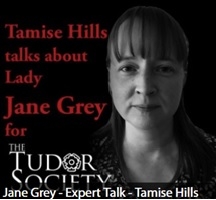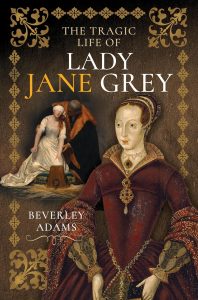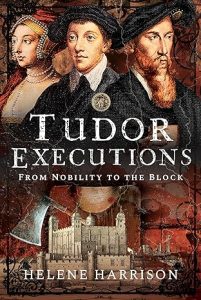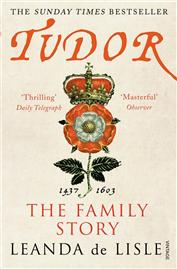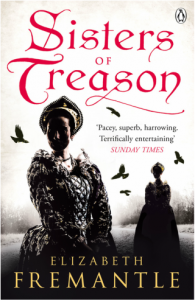Stephan Edwards is the author of ‘The Lady Jane Grey’s Prayer Book: British Library Harley Manuscript 2342, Fully Illustrated and Transcribed’ and ‘A Queen of a New Invention: Portraits of Lady Jane Grey Dudley, England’s ‘Nine Days Queen.’
‘The Lady Jane Grey’s Prayer Book’ was published in July 2016.
You can order it from:
Stephan’s website is Some Grey Matter.
Many thanks to Stephan for answering my questions.
Why did you choose this subject for your book?
I had posted a preliminary transcription of Harley 2342 (the prayer book) on my website some years ago, and site visit records indicate that it is one of the more popular pages on my site. One of the goals of my website has always been to make primary source material more readily available to those seeking to learn more about Jane Grey. But the website will last only as long as I do; when I am gone, it will cease to exist as well. So rather than see my transcription vanish some day, I thought it best to attempt to preserve it in the time-honored way: by publishing it in print. It will never be a bestseller, but at least the legal depository libraries in the UK and a selection of academic libraries in the US will have copies.
What does your book add to existing works about Lady Jane?
This book is not really about Jane Grey, as such. Instead, it adds to the body of primary sources available for use in the study of her life and times. Prior to this publication, the contents of Harley 2342 could be read only through a low-quality microfilm or, more recently, the high-resolution digital images now available on the British Library website. But since very few people are trained in reading pre-modern manuscripts, the images are useful to only those with training in paleography. And although Janel Mueller did include a transcription of Harley 2342 in her book entitled Katherine Parr: Complete Works and Correspondence, her transcription contains a significant number of errors, and the larger book containing the transcription focuses on an entirely different person. I wanted to produce a book that focused on just Harley 2342 by itself and that offers what I hope is a reliable and accurate transcription of the text of the manuscript.
What does it add to knowledge of ‘women’s devotional literature’?
Devotional literature used by women included a very wide range of materials, only one of which was the miniature prayer book. Today, books of hours receive the lion’s share of attention from scholars. Miniature prayer books have only recently begun to be looked at more closely. Harley 2342 was produced in the midst of a religious revolution in England and offers some insight into how private devotional forms were adapted in response to the changes occurring in doctrine and liturgy.
Do you agree with Janel Mueller that the prayer book was given to or bequeathed to Jane by Katherine Parr?
On the whole, I tend to treat history much as an attorney would treat a court case: unless there is very solid evidence, some “smoking gun” to reveal what really did or did not happen, I prefer to treat such propositions as more probably false than true. The evidence to support Parr’s having owned Harley 2342 is extremely circumstantial and does not allow for any real conclusion.
For example, there is simply no reliable evidence whatsoever to demonstrate that Katherine Parr ever owned Harley 2342. Mueller asserted that the manuscript was penned by Parr, which, if true, would obviously be evidence that Parr owned the book at some point. But Mueller offered no evidence of any kind to support her assertion that Parr penned the book, other than a tangential claim-in-passing to having compared the handwriting in the prayer book to an authentic example of Parr’s own handwriting. My own counter-argument that the book was instead penned by a professional scribe seems (so far) to have prevailed, to the extent that even the curators at the British Library express skepticism regarding Mueller’s claim. If Parr did not pen the book, then a huge piece of circumstantial evidence that Parr owned the book is removed.
Another bit of Mueller’s evidence, and one that I chose not to address to any extent in my book, was her claim that the so-called Kendal Prayer Book also belonged to Parr and is very similar to Harley 2342. Mueller interprets the similarity as evidence that Parr necessarily owned both. But the Kendall Prayer Book, like Harley 2342, cannot be linked in any way to Katherine Parr, other than through a popular rumor that the book may have originated at Kendall Castle, which was for some time was thought to have been Parr’s birthplace. But since we now know that Parr was *not* born at Kendall, and that the Castle was a ruin by the time Parr was an adult, the association between Parr and the Kendall Prayer Book is broken (i.e., the Kendall Prayer Book, like Harley 2342, was created after 1540, yet Kendall Castle was already a ruin by 1540 … therefore the Kendall Prayer Book cannot have come from the Castle). Further, the similarities between the handwriting and decoration of the Kendall Prayer Book and Harley 2342 may just as easily be evidence that both volumes were produced in the same scribal workshop. After all, there were a limited number of makers of handwritten miniature prayer books working in England in the 1540s.
So, in short, I can only say that there is zero reliable evidence to indicate that Harley 2342 was given to or bequeathed to Jane Grey by Katherine Parr. The idea is, in my opinion, nothing more than romantic “wishing it were so.”
Did you face any challenges transcribing the prayers?
As noted already, my preliminary transcription was derived from the old British Library microfilm of the contents of the book. That microfilm was of limited quality, however, making it difficult to read large portions of the text. Once the British Library made the digital images of the individual pages available online, it became a very easy process to edit and amend my preliminary transcription. I was very fortunate during my PhD studies to have studied paleography (reading pre-modern handwritten texts) with a master of that skill, Dr Marjorie K. McIntosh. The training I received from her made the task of transcribing from the digital images relatively easy and straightforward.
Why do you think it was doubtful that Henry Grey saw the messages written to him by Jane and Guildford (p.3)? Why would they have written them if there was no chance of him seeing them?
The issue hinges on the timing at which the inscriptions to Henry Grey were written. There are two inscriptions, both addressed to Henry Grey specifically: one from Jane and one from Guildford. Yet we know that the two were held separately in the Tower between 19 July 1553 and 12 February 1554. Since a warrant from the Privy Council was required before anyone could visit either Jane or Guildford, or even before either could go outdoors under guard, it seems highly unlikely that they were ever allowed to visit each other. So how did they both come to write in the same book? Might some official or guard of the Tower have carried the book back and forth? It seems to me very unlikely that any Tower employee would have taken such a huge risk with such high-value prisoners for so inconsequential a reason. Inscriptions are not worth losing your job (and potentially your life) over. The only time at which Jane and Guildford might have been able to speak to each other was on the occasion of their joint trial for treason on 13 November 1553. They would have been in close physical proximity to each other throughout much of that day, and there is surviving documentation indicating that Jane had at least one small prayer book with her at the trial. And in November 1553, Henry Grey was a free man, having escaped the events of July with little more punishment than having to post a huge financial bond against future good behavior. Though I have no reliable evidence to support the idea, I nonetheless strongly suspect that Jane and Guildford wrote their inscriptions on or around 13 November 1553 when they were together at trial. And having been found guilty and condemned, they expected to die within days. Jane could therefore have reasonably assumed that the book would soon make its way to her father, as her heir. But Jane did not die in November. She remained alive, and with the prayer book still in her possession, until February 1554. But by then, she knew that her father had rebelled and would surely die himself. Therefore, her inscription to her father had become moot. So she re-inscribed it to Brydges. Henry Grey probably never saw the inscriptions because the book did not leave Jane’s possession until the moment of her death, at which point it passed to Brydges. *IF* Henry Grey ever saw the inscriptions, it would have been because Brydges exercised a bit of compassion and showed the book to Grey sometime between 12 February and 23 February 1554. And while that act of compassion is certainly possible, it again seems unlikely since Brydges was no friend to Henry Grey or his fellow rebels.
Does the prayer book given any insight into Jane’s character?
I think it does, though I have chosen not to go into too much detail on this subject within this particular book. I am instead saving that material for the biography of Jane Grey that I am still hoping to get published someday soon. But I think the inscriptions, in particular, tell us something about both her intellect and her character. They are placed very carefully within the book, for example. And she seems almost to be admonishing her father in her inscription to him … an action that violated social norms of the period. Similarly, the inscription to Brydges reveals something of the nearly strident or self-righteous character of her religious faith.
‘Why a Roman Catholic official serving Queen Mary would preserve a gift from that queen’s religious and political foe is unclear (p.20 note. 53). As John Brydges had asked Jane to write a message in the prayer book for him, which she ended with the words ‘as a friend’, is it not so strange that John would keep a gift from someone he may have considered a friend?
I do not think it would be correct to characterize Brydges’ attitude toward Jane as one of “friendship.” And Jane’s own use of the word “friend” when addressing Brydges in her inscription to him should not be read using the modern connotations of that term. The two were from vastly different social and economic backgrounds. I think it would be fair to say that Brydges very probably held Jane in the regard due to a social superior. But Jane would have had very little, if any, social contact with Brydges during her imprisonment. It seems to me very unlikely that they became “friends” in any modern sense of that word. Her use of the term in her inscription is based on social convention (similar to modern letters that begin with “Dear …”), not genuine personal sentiment.
More probably, Brydges simply requested a memento of what was certainly the most famous prisoner of his career, and did so out of the same motivation that so many other jailers have requested mementos of other famous prisoners. I suspect his own motivation may even have been two-fold. Firstly, it was common enough practice for gaolers to seek some form of compensation from their prisoners. Jane’s prayer book had real financial value, even without its association with her personally. And its original binding may well have been very valuable as well. Further, Brydges may also have taken possession of her scant other goods after her execution, since there were no family members likely to claim them. Secondly, taking possession of the book may have been a bit of simple macabre souvenir-seeking on Brydges’ part, much like those who passed their own handkerchiefs through the blood that gushed from King Charles I’s severed head in 1649. But that is only speculation. The available reliable evidence simply does not tell us why Jane gave the book to Brydges in particular, nor why he kept it.
When the prayer book was on display at the British Museum, I used to view it each time I went to London. Have you viewed the prayer book?
I saw the prayer book for the first time in 1987, during my first visit to the UK. At that time, the British Library was still a department of the British Museum, with the Library occupying one wing of the larger Museum. What is now a single “Treasures of the British Library” exhibition was back then displayed in nineteenth-century wooden cabinets with glass tops scattered throughout the Library. Security was absolutely non-existent. Anyone could have walked away with anything! Now, of course, on the rare occasions when the book is displayed, it is in a secure case with alarms and unbreakable glass.
Since becoming a serious scholar in 1999, I have made numerous trips to London and the British Library in order to conduct research. I always drop in to the Treasures exhibition to see if the book is on display that day. But I have seen it only a few times. The Library has become very hesitant to leave it on display for long, owing to its fragility. I did try once, in about 2005, to gain hands-on access to the book itself. My request made its way up to the highest level, but was ultimately denied. I was forced instead to work from the old poor-quality microfilm of the book. I am enormously pleased that the Library saw fit a couple of years ago to take high-resolution digital images of the entire book and to make them available without charge online. But obviously that is not quite the same as holding the book in one’s hands … something I still hope to be able to do someday.
My other interviews with Stephan:
A Queen of a New Invention: Portraits of Lady Jane Grey Dudley, England’s ‘Nine Days Queen.




